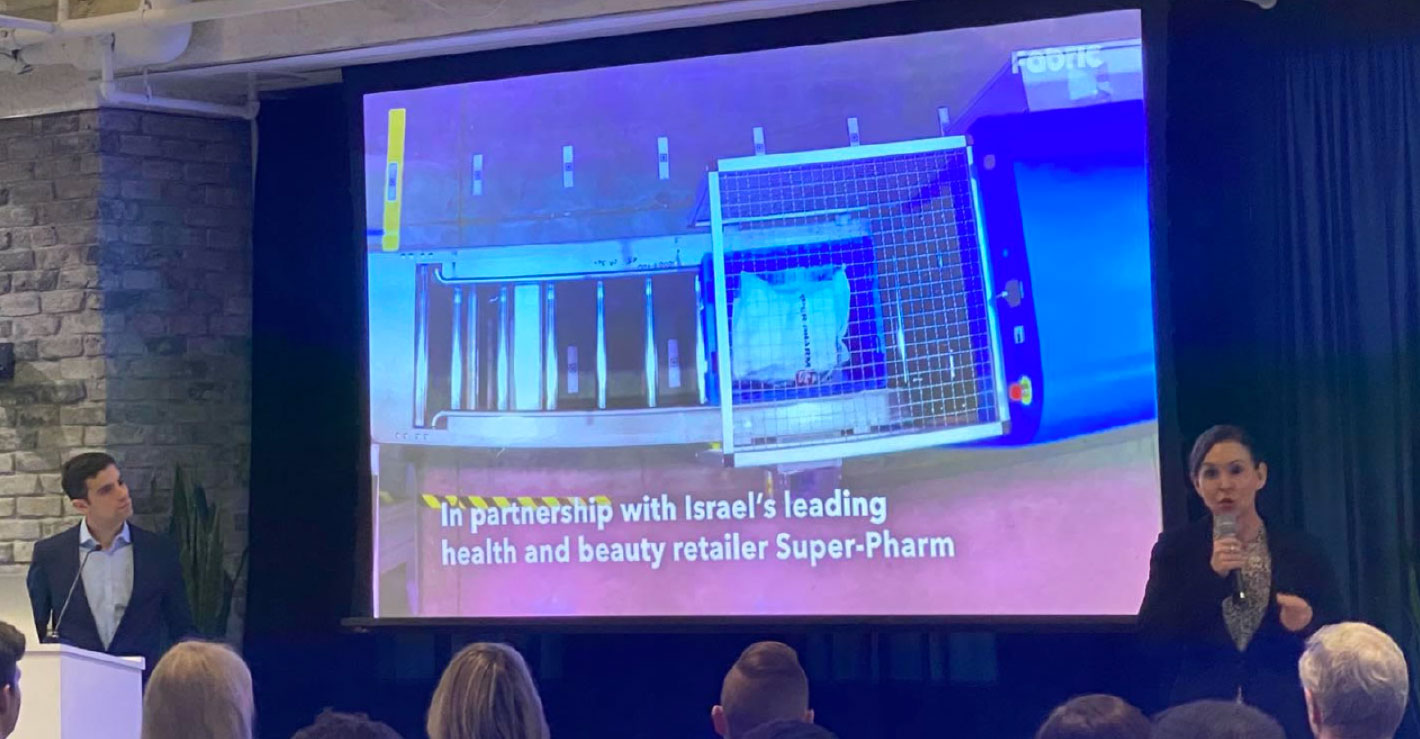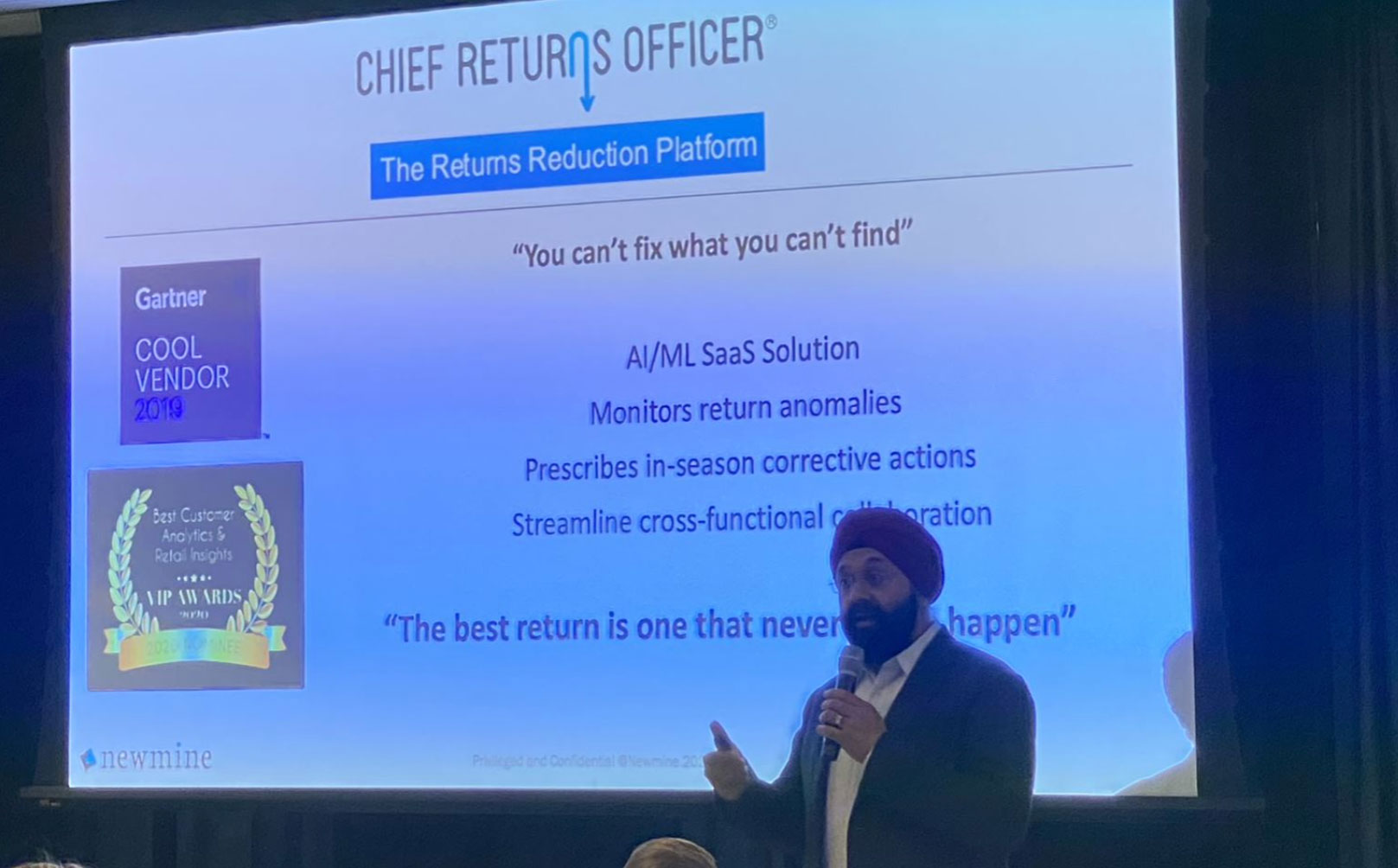
DIpil Das
On February 20, Coresight Research and the Retail Innovation Club hosted the Hype Innovation Showcase, The Future of the Store: Sustainability & Supply Chain. The event, held at the New York offices of Centric Brands, saw the attendance of many startup companies and supply chain professionals. We present key insights from the event and provide an overview of participating startups.
Transparency in Communicating Sustainability Objectives
An increasingly important part of strategic stewardship is to demonstrate consideration of, and efforts towards, sustainability practices. By communicating their objectives to the public, retailers are able to affirm their social responsibility and commitment to responsible material management, waste reduction and ethical sourcing. This represents a willingness from retailers to take accountability for the environmental impact of their business, which is key to meeting rising industry standards and consumer expectations. Retailers can use guidance from the Sustainability Accounting Standards Board and Global Reporting Initiative to develop sustainability goals and increase reporting transparency.
Technology-Enabled Operational Efficiency
Developing a deep, end-to-end understanding of the value chain enables retailers to minimize their production of waste (including damaged and recalled products) and drive operational efficiency. There are a number of technologies that facilitate this, such as by gathering relevant data to inform retailers’ decision-making and mitigate risk.
 Anne Marie Stephen, Sales Director at Fabric, discusses micro-fulfillment technology
Anne Marie Stephen, Sales Director at Fabric, discusses micro-fulfillment technology
Source: Coresight Research [/caption] Navjit Bhasin, Founder & CEO of Newmine, discusses machine learning solutions to reduce the rate of returns and automate manual tasks
Navjit Bhasin, Founder & CEO of Newmine, discusses machine learning solutions to reduce the rate of returns and automate manual tasks
Source: Coresight Research [/caption] Improving Processes Workforce engagement, such as polling the factory floor, could help to reduce inefficiencies by identifying the processes that workers believe are inefficient or not adding value. Similarly, customer engagement allows retailers to gain an insight into what shoppers consider to be important to them, and so react accordingly: Consumer desires have been found to gain momentum to the point of influencing public opinion and affecting government policy. Startups at the Event The following startups participated in the Hype Innovation Showcase: 3DLOOK is an AI-first technology company, focused on personalization in retail. It seeks to simplify data exchange between brands, retailers and customers using 3D, mobile, body-scanning technology that can generate more than 55 measurements and 3D models using just two photos on any background, according to 3DLOOK. The platform uses measurements and shape intelligence to offer a more personalized shopping experience while also optimizing the product design and development process to make better fitting products.
3DLOOK is an AI-first technology company, focused on personalization in retail. It seeks to simplify data exchange between brands, retailers and customers using 3D, mobile, body-scanning technology that can generate more than 55 measurements and 3D models using just two photos on any background, according to 3DLOOK. The platform uses measurements and shape intelligence to offer a more personalized shopping experience while also optimizing the product design and development process to make better fitting products.
 Anagog says it is “revolutionizing” the way companies understand and engage with their customers using real-time insights into how customers behave in the physical world. Using patented technology called JedAI, Anagog enables retailers to offer hyper-personalization while ensuring that customer data remains private and under the customer's control. The company claims that it has solved the historical trade-off between privacy and personalization. According to Anagog, its technology has been downloaded more than 25 million times and integrated into more than 100 mobile apps.
Anagog says it is “revolutionizing” the way companies understand and engage with their customers using real-time insights into how customers behave in the physical world. Using patented technology called JedAI, Anagog enables retailers to offer hyper-personalization while ensuring that customer data remains private and under the customer's control. The company claims that it has solved the historical trade-off between privacy and personalization. According to Anagog, its technology has been downloaded more than 25 million times and integrated into more than 100 mobile apps.
 Bringoz is a technology platform for demand-driven logistics that streamlines the process in general but specifically focuses on last-mile delivery. The platform serves a wide variety of industries, including e-commerce, food retail, CPG, FMCG, pharmaceuticals, automotive and freight.
Bringoz is a technology platform for demand-driven logistics that streamlines the process in general but specifically focuses on last-mile delivery. The platform serves a wide variety of industries, including e-commerce, food retail, CPG, FMCG, pharmaceuticals, automotive and freight.
 Fabric’s micro-fulfillment solution offers retailers same-day or within-the-hour delivery. The company says its modular, flexible design optimizes space efficiency and scales with customer needs, and that its solution can be deployed in 100 days. The company also offers service from turnkey, micro-fulfillment center-as-a-service locations.
Fabric’s micro-fulfillment solution offers retailers same-day or within-the-hour delivery. The company says its modular, flexible design optimizes space efficiency and scales with customer needs, and that its solution can be deployed in 100 days. The company also offers service from turnkey, micro-fulfillment center-as-a-service locations.
 FindMine’s machine learning solution seeks to automate manual tasks in the retail industry. According to FindMine, it automates and scales content creation so that 95% of products come with guidance on how to “complete the look” with additional products. The company says its system can create looks that are indistinguishable from those handcrafted by a merchant.
FindMine’s machine learning solution seeks to automate manual tasks in the retail industry. According to FindMine, it automates and scales content creation so that 95% of products come with guidance on how to “complete the look” with additional products. The company says its system can create looks that are indistinguishable from those handcrafted by a merchant.
 FLEXE says it is reinventing warehousing and fulfillment to optimize global delivery. FLEXE offers on-demand warehousing and works with companies to create dynamic e-commerce fulfillment networks and resolve warehouse capacity constraints.
FLEXE says it is reinventing warehousing and fulfillment to optimize global delivery. FLEXE offers on-demand warehousing and works with companies to create dynamic e-commerce fulfillment networks and resolve warehouse capacity constraints.
 Newmine helps retailers optimize retail commerce and reduce returns. Newmine says its Chief Returns Officer service is the first and only cloud-based platform that incorporates AI, machine learning and NLP technology to identify the root cause and prescribe in-season corrective actions to reduce product returns.
Newmine helps retailers optimize retail commerce and reduce returns. Newmine says its Chief Returns Officer service is the first and only cloud-based platform that incorporates AI, machine learning and NLP technology to identify the root cause and prescribe in-season corrective actions to reduce product returns.
 Outernets offers a service platform that enhances the consumer experience by using real-time data, interaction, gamification and behavioral economics. Its displays offer personalized, social, educational, interactive and transactional customer experiences, while its AI capabilities capture user interaction data in the background. The technology bridges retailers’ online strategy and brick-and-mortar stores.
Outernets offers a service platform that enhances the consumer experience by using real-time data, interaction, gamification and behavioral economics. Its displays offer personalized, social, educational, interactive and transactional customer experiences, while its AI capabilities capture user interaction data in the background. The technology bridges retailers’ online strategy and brick-and-mortar stores.
 QuickLizard offers AI-technology solutions with a portfolio of services for dynamic pricing analysis and management. The company believes the data and actionable price recommendations that its platform delivers can create accurate and unbiased pricing decisions, inventory forecasting, pricing strategy and revenue optimization, reflecting behavioral trends and market prices.
QuickLizard offers AI-technology solutions with a portfolio of services for dynamic pricing analysis and management. The company believes the data and actionable price recommendations that its platform delivers can create accurate and unbiased pricing decisions, inventory forecasting, pricing strategy and revenue optimization, reflecting behavioral trends and market prices.
 Quinyx is a workforce management software that is “revolutionizing” the way organizations schedule and optimize the workforce. Quinyx says it helps some of the world’s biggest businesses save time, money and boost productivity. The company has offices in the US, the UK and many other markets around the world. Its software is being used in Europe, North America, China, Japan and Korea.
Quinyx is a workforce management software that is “revolutionizing” the way organizations schedule and optimize the workforce. Quinyx says it helps some of the world’s biggest businesses save time, money and boost productivity. The company has offices in the US, the UK and many other markets around the world. Its software is being used in Europe, North America, China, Japan and Korea.
 Radius8 offers a solution that helps companies create hyper-local digital experiences, which the company says are now table stakes to meet today’s industry standards and consumer expectations. The platform enables retailers to dynamically merchandise online by using data from their physical stores and local market intelligence to provide contextual shopping experiences.
Radius8 offers a solution that helps companies create hyper-local digital experiences, which the company says are now table stakes to meet today’s industry standards and consumer expectations. The platform enables retailers to dynamically merchandise online by using data from their physical stores and local market intelligence to provide contextual shopping experiences.
 SIRL is an indoor GPS and customer analytics platform for brick-and-mortar retailers, an integrated solution that combines proprietary indoor GPS technology (with 12-inch accuracy) with retailers’ existing mobile apps and point-of-sale databases to provide a richer in-store shopping experience.
SIRL is an indoor GPS and customer analytics platform for brick-and-mortar retailers, an integrated solution that combines proprietary indoor GPS technology (with 12-inch accuracy) with retailers’ existing mobile apps and point-of-sale databases to provide a richer in-store shopping experience.
 Syte offers a visual AI solution that lets retailers make product discovery more intuitive. Users can upload any photo or screenshot and use that image to search for items in the retailer's inventory. With the shop-the-look and recommendation engines, users can discover similar or recommended items, offering retailers a tool to increase product exposure and average order value.
Syte offers a visual AI solution that lets retailers make product discovery more intuitive. Users can upload any photo or screenshot and use that image to search for items in the retailer's inventory. With the shop-the-look and recommendation engines, users can discover similar or recommended items, offering retailers a tool to increase product exposure and average order value.
- ERP allows retailers to anticipate issues before they occur and take preventative or corrective actions accordingly—for example, rerouting inventory, optimizing transportation and analyzing systems of behavior to prevent wasteful actions from occurring again.
- 3D digital design software is used in the apparel sector to create virtual, true-to-life renderings of garments in order to validate concepts and approve colors and patterns before production. As emphasized by Laura Ritchey, COO at Centric Brands, 3D and digital design “removes waste and inefficiencies,” as well as saving time. “It is the focus this year at Centric,” she added.
- Blockchain technology benefits retailers by offering greater transparency throughout the supply chain, thus providing easier traceability and enhanced security. For payments, blockchain removes the need for third party involvement and facilitates faster transactions through peer-to-peer, cross-border transfers of digital currency—resulting in increased efficiency for the retailer and convenience for the consumer. Pam Alabaster, Chief Marketing Officer at Centric Brands, stated that “blockchain makes sense for agriculturally based products” in the fashion sector. For instance, blockchain gives retailers the ability to track where cotton is grown and provides transparency over the raw materials’ progress through the production process. One day, we expect that this transparency will extend to consumers, so that they will be able to see the source of the products they are buying—for example, which farm provided the cotton that made a T-shirt. Sharing this information with consumers represents an opportunity for retailers to build trust with their customers, as well as enabling shoppers to make more-informed choices.
- Robotics can be employed by retailers to increase space efficiency, which is a dimension of sustainability: Reducing infrastructure requirements lowers energy consumption and improves HVAC efficiency, resulting in energy cost-savings for the retailer. Fabric is a technology company that provides micro-fulfillment services using robotics and AI. The use of robots removes the need for on-site manual labor and allows retailers to make more efficient use of their physical space. Fabric optimizes space efficiency at retailers’ sites or its third-party logistics site with a tailored solution to support each retailer’s level of inventory.
 Anne Marie Stephen, Sales Director at Fabric, discusses micro-fulfillment technology
Anne Marie Stephen, Sales Director at Fabric, discusses micro-fulfillment technology Source: Coresight Research [/caption]
- Data analytics can be used by retailers to reduce the number of returns from the e-commerce channel. Returns result in processing costs, lost revenue, potential landfill waste (from damaged products and used packaging, for example) and added logistics requirements—such as transportation, which increases carbon emissions. Reducing e-commerce returns therefore comprises one sustainability goal for many retailers. According to technology company Newmine, lost revenue for retailers as a result of returns is set to increase from $205 billion in 2020 to $290 billion in 2022. Because 65% of returns are controllable, the reduction opportunity is $133 billion in 2020 and upwards of $189 billion through 2022, Newmine stated. The company helps retailers to optimize retail commerce and reduce returns by gathering and analyzing data from multiple retail systems—merchandising, planning, product information management, product lifecycle management, order management, warehouse management, customer relationship management—as well as product reviews. Newmine uses data analytics, AI, NLP and machine learning to identify and understand the primary reasons for returns—such as sizing, product quality and misleading marketing—so that retailers can take actions to address the challenges.
 Navjit Bhasin, Founder & CEO of Newmine, discusses machine learning solutions to reduce the rate of returns and automate manual tasks
Navjit Bhasin, Founder & CEO of Newmine, discusses machine learning solutions to reduce the rate of returns and automate manual tasks Source: Coresight Research [/caption] Improving Processes Workforce engagement, such as polling the factory floor, could help to reduce inefficiencies by identifying the processes that workers believe are inefficient or not adding value. Similarly, customer engagement allows retailers to gain an insight into what shoppers consider to be important to them, and so react accordingly: Consumer desires have been found to gain momentum to the point of influencing public opinion and affecting government policy. Startups at the Event The following startups participated in the Hype Innovation Showcase:
 FLEXE says it is reinventing warehousing and fulfillment to optimize global delivery. FLEXE offers on-demand warehousing and works with companies to create dynamic e-commerce fulfillment networks and resolve warehouse capacity constraints.
FLEXE says it is reinventing warehousing and fulfillment to optimize global delivery. FLEXE offers on-demand warehousing and works with companies to create dynamic e-commerce fulfillment networks and resolve warehouse capacity constraints.
 QuickLizard offers AI-technology solutions with a portfolio of services for dynamic pricing analysis and management. The company believes the data and actionable price recommendations that its platform delivers can create accurate and unbiased pricing decisions, inventory forecasting, pricing strategy and revenue optimization, reflecting behavioral trends and market prices.
QuickLizard offers AI-technology solutions with a portfolio of services for dynamic pricing analysis and management. The company believes the data and actionable price recommendations that its platform delivers can create accurate and unbiased pricing decisions, inventory forecasting, pricing strategy and revenue optimization, reflecting behavioral trends and market prices.